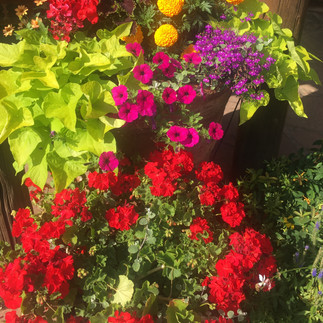The Dry-Climate Garden- Gloriously Vibrant
- Hadia Mawlawi
- Aug 12, 2021
- 6 min read
photo credit: Hadia Mawlawi
In July, my family and I got in our car and drove from Houston to Santa Fe, via some very fertile Texan land and into the high dry desert of New Mexico. It was an eye-opening adventure for someone like me who cringes at the thought of more than two hours in the car. But there was lots to discover, from the scenic rolling hills of the Hill Country to the plains traversing highway 84, and eventually linking to the historic route 66. I was taking it all in, thrilled to experience what I had only seen on T.V.
But this post is not about the myth of Texas and the cowboys of the wild west. Rather, I want to focus on something much more immediate and vital: Tending to our gardens when the world is only getting hotter.
Santa Fe surprised me with its abundance and variety of vivacious, richly-hued flora and vegetation. I could barely walk a few steps without zooming in and clicking on the glorious flowers all around me: vivid orange, intense red, lemon yellow and deep purple.
photo credit: Hadia Mawlawi
I was mesmerized by the paradox of lush vegetation in this dry environment with only 15 inches of rainfall annually.
To help me better understand this dichotomy, I reached out to the Santa Fe Botanical Garden where their head gardener, Linda Churchill, kindly answered my questions.
1- How are droughts affecting garden practices in the Southwest? On the most basic level, we have to water more than we used to. Some of us are taking this further, thinking hard about our “water budget” so we know that every gallon we spend on our garden is efficiently spent on plants that are thrifty drinkers and rewarding players. We spend a lot of time on our irrigation systems. We mulch a lot. We probably spend less time weeding and fertilizing. We choose plants that are adapted to dry climates and avoid plants that grow quickly and transpire large amounts of water through their leaves (like lawns). On a more subtle level, I find I need to make more specific choices about what plants I want to see thrive and which I can “let go” or allow nature to take care of. Some plants definitely need more regular watering, mulching, and even fertilizing than in previous decades. The plants that do well without those extra watering sessions are keepers. I do still keep some of those that require the higher inputs but I have to really love them; mediocre plants aren’t worth the water. I find I’m more willing to let the fussy plants go, especially if they need constant watering beyond the typical transplant stress period. I’m also working much more now with native plants since they are typically more adapted to our soils and able to withstand some level of drought.
photo credit: Hadia Mawlawi
Are there some species that are going to become extinct because of global warming? Well we can’t know that for sure, can we? But I can already see around my home, neighborhood, region, that the plants that are more sensitive to heat and/or drought are having a harder time recovering from year to year, than the plants that are even just a little tougher under those same pressures. For example, we see all over our region that our beloved piňon pine is suffering more and more from drought-related stressors such as piňon needle scale and bark beetle, compared to our other primary woodland tree, the one-seed juniper, which is more tolerant of heat and drought. Some people have predicted that the piňon pine is going to become very scarce in our area, if not extinct, by the end of this century. We don’t know that will happen for sure, but we do know that human activity has already impacted the lives and habits of both plants and animals through climate change and the loss of habitat. This is particularly problematic with plants (and animals) that have very small a/o specialized geographical ranges; as their ranges shrink through human pressures, those species may be more apt to shrink in numbers in the future.
photo credit: Hadia Mawlawi
2- What are some characteristics of dry-climate (low-water) plants and flowers? Dry-climate plants tend to have one or more of several characteristics: small leaves; leaves that are fuzzy or hairy, which often appear to us as silver or gray, which helps shade the plant leaves; leaves that are leathery or have a waxy or resinous coating which reduces loss of water through transpiration. Some will drop their leaves entirely during very dry years in order to reduce water loss, a process known as drought-deciduous or drought-dormancy. Some very low water plants have adapted their stems to serve as water storage (cacti), where others have huge tuberous roots that serve the same purpose (wild four o’clocks, yuccas). Many dry-land plants also have very extensive root systems that allow them to harvest water over a wide area when the precious rain does fall. 3- What would you like my readers to know about sustainable garden practices in dry areas? You can write entire books about this subject, and many have! I think gardeners really need to learn about their regional soils and native plants and also how the seasons change over the year in their gardening area, in order to garden successfully and sustainably. The amount of precipitation and when in the year it comes is very different from, say, Denver to Santa Fe to Tucson to Salt Lake City, and gardeners will be much more successful by working with that natural flow. Dry-land gardening does not mean put down weed barrier and gravel and just grow cactus, either—in fact, that kind of gardening makes the heat island effect worse, besides sterilizing your soil! Your local county extension office, master gardening group, and botanical garden, as well as social groups, should be able to help provide information and resources about best local gardening practices.
photo credit: Hadia Mawlawi
4- Is there a connection between vibrant colors and low-water gardening? I ask because I was so struck by the colorful, bright flowers in Santa Fe? One would expect brown or desert plants like succulents, rather than vivid colors found in a huge range of native flower species.
There is a lot of space between plants in the arid west, so plants need to be able to attract birds, insects and other pollinators that will help them reproduce, from long distances. Bright color is one way to do this. It might also be that the colors simply stand out more because there is a lot of brown in Santa Fe architecture. We grow lots of prairie plants as well as imports from other high-dry places around the world (Turkey, South Africa), and the combination of our adobe houses, brown gravel, and the brilliant light of northern New Mexico may just make all those colors work here, where in greener places with softer light they might look garish. 5- Anything else you would like to share about flowers and plants in arid areas? Feel free to talk about the soil if that is an important consideration. It’s important to keep your soil alive, even—or especially—in dry places. Soil is the medium where much of the plant networking takes place, and it needs plants, even if widely spaced and sparely watered, to be alive. If your water budget or your space don’t allow you to plant trees and shrubs, nurturing even small plants or grasses will keep all that fascinating microscopic life in the soil alive, and may help you keep your own connection with the earth as well. And do what you can to capture water on site rather than allowing it to run off the garden or property that you tend, since water from the sky is always less expensive and less likely to carry potentially harmful elements than water from the ground. It is important to keep as little soil as possible covered over with impermeable media such as concrete or plastic or even weed barrier, which inhibits the movement of oxygen as well as water.
photo credit: Hadia Mawlawi
I am deeply grateful to Linda Churchill for all her insights and thoughtful responses. I hope you found this interview informative too. Please click on the additional resources below for more on dry-climate landscaping and the horticulture of New Mexico.
Resources:
Hot Color, Dry Garden- Nan Sterman
This is a great resource to identify the native plants in New Mexico: https://www.npsnm.org/wp- content/uploads/2019/08/NPGuide_SantaFe_Gardening_Landscape.pdf




































Comments